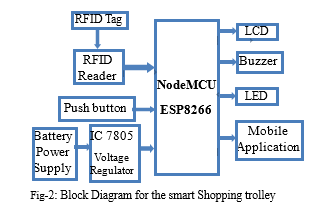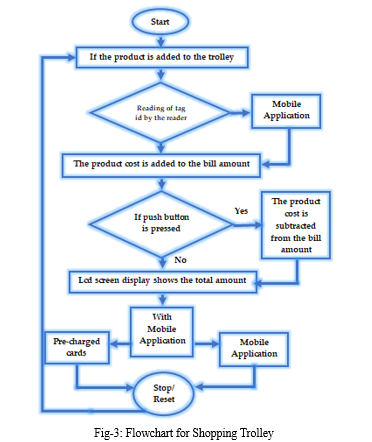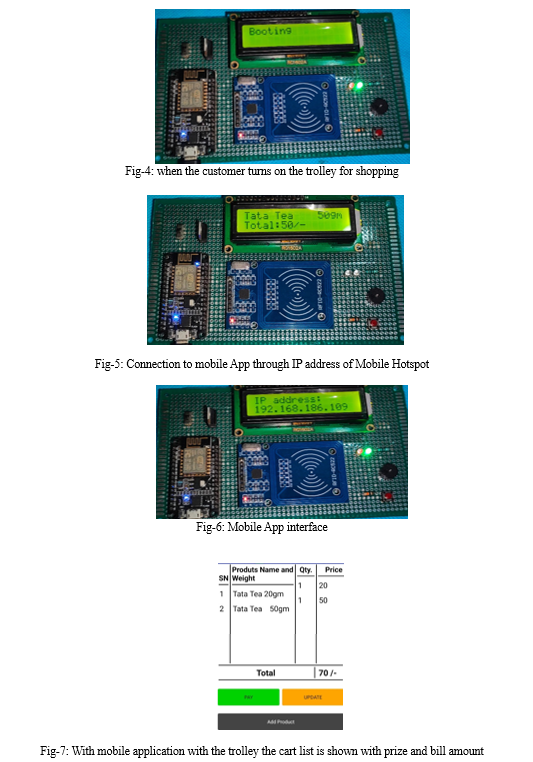Ijraset Journal For Research in Applied Science and Engineering Technology
- Home / Ijraset
- On This Page
- Abstract
- Introduction
- Conclusion
- References
- Copyright
Smart Shopping Trolley with Shopping Application
Authors: Prof. Deepika Bairagi, Deepa Kunwar, Bhupesh Rathore, Ritesh Haldar, Santosh Ku. Gupta
DOI Link: https://doi.org/10.22214/ijraset.2024.61123
Certificate: View Certificate
Abstract
The current shopping method used in Indian supermarkets and malls is time-consuming, as customers have to wait in long queues for billing even though they can roam and select their products with a trolley. To handle large crowds, we need to reduce the time spent on the billing process. This can be achieved using a smart shopping system based on RFID technology. Each smart trolley is equipped with an RFID reader, an LCD display, a NodeMCU ESP8266 and each product with RFID tags. The list of items and their costs are displayed on the LCD screen. The IoT-based trolley simplifies shopping and enhances security. Using WiFi, customers can connect to a mobile application which displays their purchases and allows them to pay their bills through the app.
Introduction
I. INTRODUCTION
In our day-to-day life, we see that the use of computing technology and innovative applications has increased rapidly. Many people are connected to this digital world through their smartphones and laptops because of high-speed internet connectivity, user-friendly interfaces, and personalized recommendations. This has made things simpler and easier. New technologies such as social media have given users a better and broader perspective on many items and information about various products in their daily life and ensure that they are of the best quality. As our cities are overpopulated, the diversity of wants and needs of the people is also huge. As a result, many people prefer to go to malls and supermarkets to buy different varieties of commodities. The main drawback is that the large number of people coming to shopping malls and supermarkets, which creates a huge rush and each has to wait in queues for billing. Customers have to wait a long time in a queue to scan their items and pay the bill. An automated smart shopping system has been implemented by introducing the concept of IoT with RFID technology. In this system, an inexpensive RFID tag is attached with each product. When the customer wants to purchase a product, firstly the should scan the product tag on RFID reader. Hence, billing is made from the shopping cart itself, preventing customers from waiting in a long queue at checkout. This system makes both the customer's and supermarket employee's work easier by reducing the time it actually takes with the old method of billing, i.e., manual billing technique.
II. LITERATURE SURVEY
- Automation Product Detection and Smart Billing for Shopping using Light-Fidelity
Authors: Ezhil Azhagan, R. Adithya, Y.L. Burhanuddin, F. Charles
Published in: IEEE Conference 2022
It features an automatic product recognition system that uses optical fibres and Li-Fi technology. Payments can be processed through mobile banking or electronic payment systems, allowing the cart system to verify products and complete transactions successfully.
2. Innovative Shopping Cart for Smart Cities
Authors: Prasiddhi K, Dhanashree H. Gawali.
Published in: IEEE Conference 2021
An unconventional novel product that is accepted by society is one that brings contentment, satisfaction, and benefits, enhancing coherence in the day-to-day life of the common man. The innovative shopping cart is a system developed to assist a person in daily shopping by automating the traditionally manual process. This system helps minimize the time required for shopping by ensuring products are purchased at reasonable prices and with the best offers. The system consists of four key modules: (i) Product Detection (PD), (ii) Product Recommendation (PR), (iii) Budget Setting (BS), and (iv) Automatic Billing (AB). PD uses RFID technology to detect products placed in the shopping cart, while PR provides relevant product information and current offers. BS allows for setting a budget, and if the purchase cost reaches this budget value, a buzzer sounds. Automatic billing generates the bill from the counter server through RF communication. These four modules are integrated into an embedded system and have been tested to satisfy the required functionality. The main aim of this project is to enable automatic billing to avoid queues in malls and supermarkets.
In this paper, we showcase our project ideas. Our project involves using a NodeMCU, an LCD display, an RC522 Reader Module, RFID tags and wiring. When a customer begins shopping, each product is attached with a unique RFID tag. The unique code of the RFID tag is scanned by the RC522 Reader, and the price of the product is displayed on the LCD display. To address these challenges, we have developed a smart trolley based on IoT with an advanced billing system that simplifies shopping and accelerates the checkout process. This system also helps maintain social distancing and reduces the need for customers to stand in long queues.
III. METHODOLOGY
A. Software Specification And Requirements
- Arduino IDE
The Arduino IDE (Integrated Development Environment) is the software used for programming Arduino boards. It has unique features designed for writing, testing, and debugging code. The IDE supports multiple operating systems, including Windows and Linux, and the programming languages C/C++. As open-source software, it allows users to write their own functions and extend its capabilities. There are several types of Arduino boards supported, such as Arduino Ethernet and Arduino Mega are saved with the `.ino` file extension.
2. NodeMCU ESP8266
NodeMCU is an open-source firmware and development kit that aids in prototyping or building IoT products. It includes firmware that runs on the ESP8266 Wi-Fi SoC from Espressif Systems, which is a System on Chip (SoC) Wi-Fi microchip for Internet of Things (IoT) applications. The firmware uses Lua scripting language.

Key points
- NodeMCU ESP8266 features an ESP8266EX core WiFi SoC and a Tensilica L106 32-bit processor within the same chip.
- Additionally, NodeMCU ESP8266 offers 2.4 GHz b/g/n WiFi with an onboard antenna to support WPA/WPA2.
- It operates on 2.3-3.6V and draws 80mA current, with a temperature range from -40?C to 125?C.
3. RFID Reader
The RC522 RFID Reader module works on 13.56MHz electromagnetic field that is used to communicate with the RFID tags (ISO 14443A standard tags). The reader will communicate to the microcontroller over a 4-pin which is called as Serial Peripheral Interface (SPI) with a maximum data rate of 10Mbps. It can also provide communication over I2C and UART protocols. The operating voltage is from 2.5 to 3.3V, but it can go up to 5-volt, so we can connect it to an Arduino or any other logic microcontroller that operates on 5V without using any logic level converter.
4. RFID Tag
They are a type of tracking system that uses smart barcodes to identify items. RFID, short for "radio frequency identification," utilizes radio frequency technology. It is also referred to as an RFID chip.
There are two main types of RFID tags:
- Battery-operated RFID Tags: It contain an onboard battery as a power supply. They might also be called active RFID tags.
- Passive RFID Tags: They are not battery-powered and instead work by using electromagnetic energy transmitted from an RFID reader.
5. 6x2 LCD Display with I2C Module
It can display up to 16 characters per line within 2 lines and operates through a built-in controller that can execute a series of commands by understanding them. The I2C LCD uses the I2C communication interface to transfer the information required to display the content. An I2C LCD requires only 2 lines (SDA and SCL) for transferring the data. Therefore, the complexity of the circuit is reduced.
6. Push Button
A push button is a simple switch, which is normally open or normally closed. It is made of either plastic or metal and is placed in circuits to control any process manually. When the button is pressed, it closes; otherwise, it remains in the open state.
B. Block Diagram

C. Proposed System
In this section, hardware components are required to implement the project is discussed. Figure 2 represents the block diagram of the proposed idea. The block diagram contains components for the trolley section, RFID section and also includes an LCD display with Mobile Application. Then, every subsystem interfaces with each other to shape the entire module. In the proposed system, the ESP8266 serves as the heart of the model, integrated with the RFID reader, LCD module, RFID tags, and auxiliary components. This hardware unit is connected to the software system, which is a mobile application that requires a common Wi-Fi hotspot connection. The application displays product ID, cost, and other details. This entire unit is attached to the trolley, and each product has an RFID tag. Customers add products to the trolley, and the total amount is displayed on the LCD display. The payment can be made online or via any precharged card of the customer. When the customer's shopping is done, they press the switch to end the shopping.
D. Flowchart
Every product in the supermarket and mall is equipped with a Radio Frequency Identification (RFID) tag operating at 13.56 MHz, and each carrying or moving equipment, such as a trolley, is equipped with an RC522 reader. When a customer picks up a product, the RFID tag attached to the item is scanned by the RC522 reader through wireless transmission. Each RFID tag has a unique 12-digit code known as an EPC. The result is displayed on an LCD screen, which updates the total amount as shown in Figure 7 and Figure 8.

The data is displayed on the mobile phone with the help of the Wi-Fi module built into the ESP8266. When customers wish to remove an item from their cart or trolley, they must scan the item's tag again while pressing the push button; this action will subtract the item from the bill. Additionally, if any product is scanned twice, the LCD will display "Already Added" to prevent any errors during the billing process. At the end of shopping one can press on reset button (RST) on ESP8266 to restart the shopping.
IV. RESULT
In previous and present times, each shopping mall has a different billing system. From the customer's point of view, in supermarkets, most of the time is spent dealing with the billing system. Therefore, "Smart Shopping Trolleys with Automatic Billing" are used to solve this problem. When a customer enters the shopping mall, they take a trolley and can connect to the app via Wi-Fi if they want mobile access too.
When no products are placed in the cart/trolley, it shows the total amount as 0, as shown in figure 6. When products are added after scanning the RFID tags, the number of items and price will be updated, as shown in figure 7. The removal of undesired products from the cart can be done by scanning the respective item's RFID tag again while pressing the push button. The number of items and price will be reduced correspondingly, as shown in figure 8. After completing the purchase of products, the final bill will be displayed on the LCD display or on the app.
Then, the payment can be done through an online mode of transaction or through precharge cards. Once the shopping is done, the customer presses the RST button, indicating the end of shopping. Now, the cart is ready for the next customer to shop. The main objective of this project was achieved, i.e., saving time for the customer.


Conclusion
The work is done with the help of RFID technology, an RC522 reader, RFID tags, and NodeMCU ESP8266. Its aim is to reduce the time of billing for customers and ease the shopping process for their benefit. It can be used in the super bazars and malls where there is a huge rush and crowd where it is difficult to maintains the customer service. In the world of automation, this technology will replace the barcode system currently in use. RFID technology is very easy to use for old customers, requiring no extra effort. This system is also called a human-friendly smart trolley with an automated billing system. This technology provides many benefits. Nowadays, people depend on digital money transactions like UPI payments, which our system supports, making it very easy and fast. When a product is bought, the name of the product, its cost, and the total bill are displayed on the LCD. The program is dumped into the cart, saving time for the client and reducing labor work. Hence, this technology can help people make their shopping easy and time-saving without much human intervention. This also reduces manpower and shopping mall maintenance.
References
[1] Chandrashekhar P, Ms.T. Sangeetha ?Smart shopping cart with central billing system through RFID and zigbee, IEEE,2014 [2] Hubert, M. Blut, C. Brock, C. Backhaus and T. Eberhardt ? “smart phone based mobile shopping”: mobile benefits, customer characteristics, perceived risks and the impact of application context, IEEE 2018. [3] “IoT Applications on Secure Smart Shopping System\" conference paper by Ruinian Li, Tianyi Song, Nicholas Capurso, Jiguo Yu, Jason Couture, and Xiuzhen Cheng. [4] Zeeshan Ali, Reena Sonkusare, \"RFID based Smart Shopping: An Overview\" in International Conference on Advances in Communication and Computing Technologies, Mumbai, Aug 10-11, 2014. [5] \"Innovative Shopping Cart for Smart Cities \" by Prasiddhi K. Khairnar, Dhanashri H. Gawali, in IEEE International Conference current Trends in Electronics Information & Communication Technology (RTEICT), Bangalore, May 19-20, 2017, pp.1067-1071. [6] Mr.P.Chandrasekar, Ms.T.Sangeetha, \"Smart Shopping Cart with Billing System through RFID and ZigBee\" in IEEE S.A. [7] Tharindu Athauda, Juan Carlos Lugo Marin, Jonathan Lee, Nemai Karmakar, \"Robust low-cost passive UHF RFID based smart shopping trolley\" in IEEE Journal of Radio Frequency Identification, vol 2., no.3, Sept2018. [8] Bita A. A. Saud Al-Humairi, S.N.Binti Mohamad Azlan, A.S.2021.Towards A Sustainable Development Cities Through Smart Shopping Trolly: A Response to the Covid-19 Pandemic, IEEE 11th IEEE Symposium on Computer Applications & Industrial Electronics (ISCAIE).
Copyright
Copyright © 2024 Prof. Deepika Bairagi, Deepa Kunwar, Bhupesh Rathore, Ritesh Haldar, Santosh Ku. Gupta. This is an open access article distributed under the Creative Commons Attribution License, which permits unrestricted use, distribution, and reproduction in any medium, provided the original work is properly cited.

Download Paper
Paper Id : IJRASET61123
Publish Date : 2024-04-27
ISSN : 2321-9653
Publisher Name : IJRASET
DOI Link : Click Here
 Submit Paper Online
Submit Paper Online

